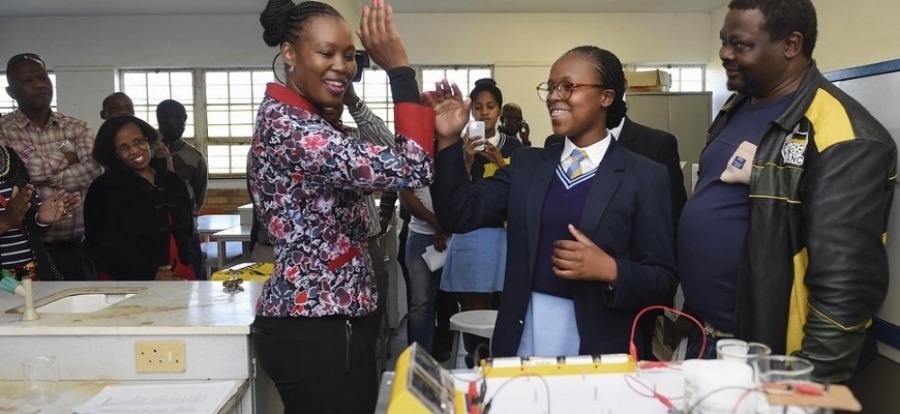"Science lessons can inject life into the classroom while ensuring children are learning at the same time."
Science teachers across the UK are by now well up to speed with the new primary science curriculum, and many will have realised a lot of the content is the same as before. However, the main changes are the inclusion of evolution and inheritance, digestion, fossil formation, the digestive system, gears, levers and pulleys and a greater emphasis on identifying and classifying plants and animals.
Science lessons have the potential to be so much fun for children, injecting life into the classroom and ensuring children are learning at the same time. Using a range of practical ideas and hands on experiments can help make science a more ’real’ concept, helping to give context to their learning.
There are certain subjects in the science curriculum, such as evolution, that may not have been covered by teachers before, or you may have taught previously to a different year group. This might mean you have to take a different approach to the way in which you teach the subject. Therefore, I have outlined some top tips for teaching the new science curriculum, in order to help guide primary teachers with lessons in this subject.
Practical Experiments
Why not take the class outside for a lesson? This can make it more exciting for the children and providing first-hand experiences of the local environment at the same time. By taking the learning outside, children can develop important fieldwork skills. The children can collect and observe animals and plants in their habitats and record seasonal activity over the year, and discuss how plants and animals have evolved to survive over time.
Certain practical experiments can also have various potential opportunities for cross-curricular links; bringing information and communication technology (ICT) into science lessons for example. Teachers are turning to ICT to make science more practical and exciting by using tools such as data-loggers, blogs, YouTube video clips and digital microscopes. By using these tools it not only makes it easier to explain science, but students are also learning about technology. It makes it much more fun and engaging. Other examples of this is the use of iPads and tablets, as there are plenty of hands-on experiments and creative investigations that can be implemented with the use of these tools. For example the children could use the iPad camera to make short films or animations to explain processes such as life cycles. Engaging the subject in a way that allows students to relate it to the real world will help them to have a better understanding of science.

Exhibitions and Class Trips
Another useful idea is to take your students to science weeks or science exhibitions. Science clubs also provide opportunities for children to think about the subject. Science clubs can also promote STEM activities to widen children’s experience and inspire the scientists of the future. Class trips will help motivate your students to learn, so why not visit a local farm or a science and natural history museum?
Pinterest
I think it’s important that teachers share information on lessons and resources as much as possible. I use the social media tool ‘Pinterest’ a lot and find it very useful. I share ideas and lessons with other teachers and with my student teachers too. It lets you build ‘boards’ and easily ‘pin’ parts of the web (blog posts, images, videos, websites, etc.) onto those boards. Of course, if you are not on Pinterest there are plenty of other ways of sharing information such as various websites and interactive resources, but Pinterest is a quick way to gather creative ideas for lesson plans.
"Take your students to science weeks or science exhibitions; science clubs also provide opportunities for children to think about the subject."
Cross Curricular Lesson Plans
Carefully planned lessons could also incorporate other subjects. For example, a science lesson on changing states using chocolate could also be linked to literacy by reading Charlie and the Chocolate Factory, and perhaps doing some creative writing sessions thinking of stories related to chocolate.
Chemistry experiments that involve measuring can also bring in a practical use of maths, too. Other lessons, such as exploring seasonal changes, can help to integrate science and geography. Also bringing in art to aid a science lesson can help promote brain activity and engagement, encouraging them to take a more creative approach to scientific concepts, as well as making lessons easier for the children to understand. Investigating shadow puppets is a great example of this; encourage students to create their own puppets to tell traditional hindu stories. This way, the children learn about which materials make good shadows and how to manipulate the size of the shadow produced for dramatic effect. It also provides them with the opportunity to perform as well as learn about the traditional hindu tales.
Primary school is where an early interest in science can begin to blossom, so by making a few simple changes to the way science is taught, schools can play an integral part in creating enthusiasm in this subject from a young age. A student that doesn’t engage with science in early years is unlikely to continue the subject in secondary school or university, which is why it’s important to encourage our students early on and spark an interest for our future scientists and engineers.
How do you make STEM subjects fun? Let us know in the comments.


















